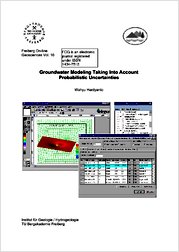| dc.contributor.author | Hardyanto, Wahyu | |
| dc.contributor.editor | Merkel, Broder J. | |
| dc.date.accessioned | 2010-12-12T21:58:15Z | |
| dc.date.available | 2010-12-12T21:58:15Z | |
| dc.date.issued | 2003 | |
| dc.identifier.citation | Freiberg Online Geosciences; Vol. 10.2003 | |
| dc.identifier.uri | http://hdl.handle.net/11858/00-1735-0000-0001-349C-C | |
| dc.identifier.uri | http://hdl.handle.net/11858/00-1735-0000-0001-349C-C | |
| dc.description.abstract | Auf Basis der Finite-Elemente-Methode wurde ein 3-D-Grundwassermodell weiterentwickelt,
das Dichteabhängigkeit berücksichtigt und für gesättigte und ungesättigte poröse
Medien gilt. In das Transportmodul ist die Finite-Elemente-Methode mit dem hybriden
Lagrange-Euler-Verfahren integriert. Für die Modellkalibrierung sowie die Sensitivitäts- und Unsicherheitsanalyse wurde ein probabilistischer Ansatz, das Latin-Hypercube-Sampling-Verfahren mit restriktem Paarungsalgorithmus, integriert. Die Stärke der Beziehung zwischen
Parametern und Ergebnis (Wasserstände, Fließgeschwindigkeit Konzentrationsverteilung) wird durch die Koeffizienten der partiellen oder der Standard-Rangkorrelation ermittelt. Dies ermöglicht die Handhabung eines breiten Spektrums realer Probleme. Eine Verifizierung des Codes wurde erfolgreich an vier Beispielen gezeigt. Die Benutzerfreundlichkeit wurde durch die Entwicklung einer grafischen Oberfläche für Eingabe und Ausgabe garantiert. | |
| dc.description.abstract | A 3-dimentional finite element groundwater model for density-dependent flow and transport through saturated-unsaturated porous media with stochastic approach (i.e. Latin Hypercube Sampling) FEMWATER-LHS has been developed. This code comes with an Argus ONETM GUI (Argus Open Numerical Environments Graphical User Interfaces). The combined flow
and transport can handle a wide range of real-world problems. The hybrid Lagrangian-
Eulerian finite element method was incorporated in the transport module. Four problems were employed for verification by comparing numerical results from the model and from other models. The Latin Hypercube Sampling with the restricted pairing algorithm is used as a tool for sensitivity and uncertainty analysis. Sensitivity and uncertainty analysis are parts of model
development, which should be performed within model calibration and before doing any
prediction by modeling. To demonstrate the applicability of the model capabilities, the Latin Hypercube Sampling was performed for four applications, analyzing the sensitivity of different models output of FEMWATER-LHS, such as pressure head, flow rate through
boundary condition and concentration. Based on this type of analysis the most important input parameters for a certain output can be determined. The analysis of uncertainty propagation associated with input parameters will result in estimation of cumulative distribution function of the model output. | |
| dc.description.sponsorship | Deutscher Akademischer Austauschdienst;
Government of Indonesia | |
| dc.format.mimetype | application/pdf | |
| dc.format.mimetype | application/pdf | |
| dc.language.iso | eng | |
| dc.publisher | Geologisches Institut <Freiberg> | |
| dc.relation.ispartofseries | Freiberg Online Geosciences | |
| dc.subject.ddc | 551.4 | |
| dc.subject.gok | UBG 100 | |
| dc.subject.gok | UBG 700 | |
| dc.subject.gok | VBQ 200 | |
| dc.subject.gok | VBQ 300 | |
| dc.title | Groundwater Modeling Taking Into Account Probabilistic Uncertainties | |
| dc.type | article | |
| dc.subject.gokverbal | Grundwasserbeobachtung/-erkundung {Hydrologie, Unterirdische Gewässer} | |
| dc.subject.gokverbal | Grundwasserbewegung {Hydrologie, Unterirdische Gewässer} | |
| dc.subject.gokverbal | Grundwassermodelle {Hydrogeologie} | |
| dc.subject.gokverbal | Grundwasserbewegung {Hydrogeologie} | |
| dc.bibliographicCitation.volume | 10 | |
| dc.identifier.doi | 10.23689/fidgeo-876 | |
| dc.type.version | publishedVersion | |
| dc.relation.issn | 1434-7512 | |
| dc.relation.volume | Freiberg Online Geosciences; Vol. 10.2003 | |
| dc.bibliographicCitation.journal | Freiberg Online Geosciences | |
| dc.relation.collection | Geologische Wissenschaften | |
| dc.description.type | research | |


